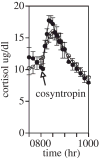Adrenocortical and pituitary glucocorticoid feedback in abstinent alcohol-dependent women
- PMID: 20331575
- PMCID: PMC4038906
- DOI: 10.1111/j.1530-0277.2010.01164.x
Adrenocortical and pituitary glucocorticoid feedback in abstinent alcohol-dependent women
Abstract
Background: The long-term ingestion of alcohol diminishes hypothalamic-pituitary-adrenal (HPA) axis reactivity in alcohol-dependent men, potentially altering future relapse risk. Although sex differences in HPA axis functioning are apparent in healthy controls, disruptions in this system have received little attention in alcohol-dependent women. In this study, we assessed the basal secretory profile of adrenocorticotropic hormone (ACTH) and cortisol, adrenocortical sensitivity in both the presence and absence of endogenous corticotropic pituitary activation, and feedback pituitary glucocorticoid sensitivity to dexamethasone.
Methods: Seven women 4- to 8-week abstinent alcohol-only dependent subjects and 10 age-matched female healthy controls were studied. All subjects were between 30 and 50 years old, not taking oral contraceptives, and were studied during the early follicular phase of their menstrual cycle. Circulating concentrations of ACTH and cortisol were measured in blood samples collected at frequent intervals from 2000 to 0800 hour. A submaximal dose of cosyntropin (0.01 microg/kg), a synthetic ACTH (1-24), was administered at 0800 hour to assess adrenocortical sensitivity. In a separate session, low-dose cosyntropin was also administered following high-dose dexamethasone (8 mg intravenous) to assess adrenocortical sensitivity in the relative absence of endogenous ACTH. In addition, the ACTH response to dexamethasone was measured to determine the pituitary glucocorticoid negative feedback. Sessions were 5 days apart, and blood draws were obtained every 5 to 10 minutes.
Results: Mean concentrations and pulsatile characteristics of ACTH and cortisol over 12 hours were not statistically different between the 2 groups. Healthy controls had a somewhat higher (p < 0.08) net peak, but not net integrated, cortisol response to cosyntropin relative to the alcohol-dependent women. There were no significant group differences in either the ACTH or cortisol response to dexamethasone nor in the net cortisol response to cosyntropin following dexamethasone.
Conclusion: Significant differences in pituitary-adrenal function were not apparent between alcohol-dependent women and matched controls. Despite the small n, it appears that alcohol-dependent women do not show the same disruptions in HPA activity as alcohol-dependent men. These findings may have relevance for gender-specific treatment effectiveness.
Figures





References
-
- Adinoff B, Martin PR, Bone GHA, Eckardt MJ, Roehrich L, George DT, Moss HB, Eskay R, Linnoila M, Gold PW. Hypothalamic-pituitary-adrenal axis functioning and cerebrospinal fluid corticotropin releasing hormone and corticotropin levels in alcoholics after recent and long-term abstinence. Arch Gen Psychiatry. 1990;47:325–330. - PubMed
-
- Adinoff B, Risher-Flowers D, De Jong J, Ravitz B, Bone GHA, Nutt DJ, Roehrich L, Martin PR, Linnoila M. Disturbances of hypothalamic-pituitary-adrenal axis functioning during ethanol withdrawal in six men. Am J Psychiatry. 1991;148:1023–1025. - PubMed

